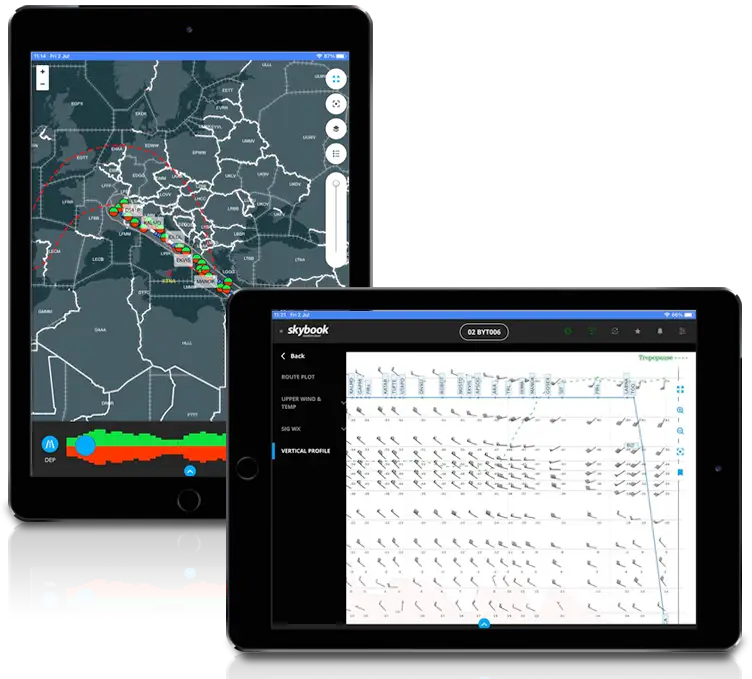
Why offline sign off matters on pilots EFB
To help understand what an electronic flight bag is, let’s first begin with a traditional pilots flight bag…
So a pilot flight bag is what you would expect. A briefcase that is used by the pilot to carry aircraft operational manuals, navigational charts, pilot logbooks, flight checklists, paper briefing packs and any other documentation relating to the pilot or the scheduled flight. All this is typically kept within the cockpit.
As you can imagine, carrying all those flight documents sure can add weight to the plane, this could be around 18kg or more! Compared to the weight of a tablet typically no more then 2kg.

An EFB is a digital app device mostly used on an ipad or tablet on flight deck, and it is often the responsibility of an EFB manager to provide staff training keep the app up-to-date. EFBs store all the flight briefing information, flight charts and documentation, to help improve the efficiently of a pilot and the flight crews workflow, whilst saving paper in the process.
The skybook electronic flight bag offers another communication channel for flight dispatchers to be able to message pilots and send them flight briefing updates using the flight dispatch software.
An EFB app can contain and integrate a huge array of flight information, such as the operational flight plan, crew rosters, flight scheduling, load sheets, weather / NOTAM data and much more.
With the use of integration or system APIs; EFBs can easily calculate certain aviation data such as fuel usage, flight performance, and weight & balance. Traditionally this would commonly be carried out using printed references or handed over to flight crew by the flight dispatchers.
Using an EFB for a pilot brief and logging data throughout each phase of a flight can save flight crew and operator’s precious time. In turn helping to improve flight on time performance for the airline.
There are currently three software classifications for an EFB app. Type A and B are both considered portable electronic devices, whereas Type C is part of installed aircraft equipment. Here’s the types of EFB in more detail:
Type A
These are static digital applications that replace paper, such as document file viewers for PDFS, HTML, XML, etc. This could also include viewing digital aircraft operating manuals, and NOTAM information for airports and alternates. Intended for use during flight planning, pre flight and any flight phases that aren’t critical.
Type B
These tend to be more dynamic and interactive with panning, scrolling and zooming options. Often including the same information from Type A, but with extra features such as interactive weather map information, briefing charts, pilot briefing packs and inputting data for each flight phase into a journey log; such as the nav log.
Type C
Type C contains more critical flight phase information, that is used as a multi-function display, which allows pilots to see the navigation route, weather radar, traffic collision avoidance, etc. Type C EFB can only be used on installed equipment and need a supplemental type certificate approved by the FAA.

Although an electronic flight bag is primarily intended for flight deck use according to the FAA's Advisory Circular (AC No. 120-76D); EFB software capabilitiy is evolving to provide so much more for airlines, aviation companies and helping to increase the pilot’s situational awareness. That is evident with the global electronic flight bag market size estimated to grow from ¢2.9 billion in 2021 to roughly $5.8 billion in 2028 (fortune business insights)
Here are a few examples of other ways an electronic flight bag adds value to operations:

There are many benefits to flight crew and airlines by using an electronic flight bag, such as:

The FAA is committed to developing policies for the ever evolving future EFB technology, to ensure that the demands of the aviation industry are met and EFB software can continue to provide efficient improvements for airlines and operators.
The skybook EFB is well established within the electronic flight bag industry since early 2000s and is making a difference to many low-cost carrier airlines, private jets and regional arilines looking to streamline their flight operations and find cost-savings. When it comes to answering what is an electronic flight bag, the skybook aviation cloud provides more than just an award winning EFB.
We are committed to connecting the workflow of airlines so that communications with flight dispatchers and pilots are streamlined, and the flight crews workloads are more efficient an.
An electronic flight folder could be confused with an EFB, but it differs slightly. The EFB is essentially the tablet application the pilots use; whereas the EFF is the briefing information that is collated and transferred onto the EFB app. Learn more about an electronic flight folder.
Learn more about the skybook aviation software and also check out the top EFB questions asked by airlines and aviation businesses.
Get access to our latest news & skybook updates